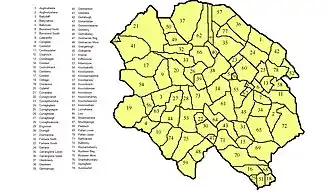When researching Irish genealogy, it can be confusing trying to understand the different terminology used for describing the unique Irish land divisions. Terms such as Townlands, Civil Parishes and Baronies can seem puzzling, as there are very few equivalents found elsewhere that are still in regular use.
Research your ancestors on MyHeritage
TownlandsTownlands

The townland is the smallest territorial division of civil administration. Townlands can provide us with a traceable address to the present day for our ancestors. Up until very recently, many rural areas still used the townland as their primary address. Dating from medieval times or earlier, townlands were used to identify a small area of land at a local level. These divisions were later used as the basis for plantation grants in the sixteenth and seventeenth centuries and were considerably altered following subdivisions. The townland was used, not only for regular land transactions such as the imposition of rents, but also as the primary division in major land valuations, surveys and census such as the Tithe Applotment books and Griffith’s Valuation. Its significance now lies primarily in enabling the identification of small, localised rural areas. Parts of an individual townland may lie in different civil parishes and may also be in different Roman Catholic parishes.[1] The same townland names can be found in different parishes and counties.
Until the 19th century most townlands were owned by single landlords and occupied by multiple tenants. The cess, used to fund roadworks and other local expenses, was charged at the same rate on each townland in a barony, regardless of its size and productive capacity. Thus, occupiers in a small or poor townland suffered in comparison to those of larger or more fertile townlands. This was reformed by Griffith's Valuation.
The total number of inhabited townlands was 60,679 in 1911. The total number recognised by the Irish Place Names database as of 2014 was 61,098, including uninhabited townlands, mainly small islands. Features included in this data cover 50,534 boundaries.[2] Aside from Ireland, townlands are also fund in the Western Isles of Scotland.
Civil ParishesCivil Parishes
Historically there were three classes of parish in Ireland: the civil parish, the Church of Ireland parish and the Roman Catholic parish. The first two generally (but not always) had the same boundaries, while the third generally did not. As a result of the 16th century Protestant Reformation, the Roman Catholic church had to adapt to a structure based on towns and villages, with parishes that were generally larger than the old parishes. Further reforms carried out by the Catholic Church in Ireland in the 1800s led to more distinct changes in the layout of their parishes.
The Irish civil parish was originally based on the Gaelic territorial unit called a túath or Trícha cét. Following the Norman invasion of Ireland, the Anglo-Norman barons retained the tuath, later renamed a parish or manor, as a unit of taxation. The civil parish was formally created by Elizabethan legislation in the 1500s. Accounts were kept of income and expenditures for each parish including pensions and poor relief.
Civil parish boundaries typically correspond to modern Church of Ireland parish boundaries. Knowing the name of the civil parish is important regardless of the religion of your ancestors because it is how tax records were organized. Their use as administrative units was gradually replaced by the poor law divisions in the 19th century, although they were not formally abolished. They are still sometimes used today for legal purposes.
At the time of the Cromwellian conquest of Ireland, in 1654–56, a Civil Survey was taken of all the lands of Ireland. It proved inaccurate, and in 1656–58 the Down Survey was conducted, using physical measurements to make as accurate a map as was possible at the time of the townlands, parishes and baronies. This became the basis for all future land claims. Parishes are an intermediate subdivision, with multiple townlands per parish and multiple parishes per barony. A civil parish is typically made up of 25–30 townlands but some can be much larger. A parish may cross the boundaries of both baronies and counties. In some cases, the civil parish may be in several geographically separate parts.
Civil Parishes were included on the nineteenth century maps of the Ordnance Survey of Ireland.[3] The Local Government (Ireland) Act 1898 established administrative counties divided into county districts (urban districts and rural districts) making parishes largely obsolete, and they were removed from subsequent editions of OS maps.[4] For poor law purposes district electoral divisions replaced the civil parishes in the mid-nineteenth century.
Civil Parishes in Ireland are sometimes still used for legal purposes, such as to locate property in deeds of property registered between 1833 and 1946.[5]
BaronyBarony

A barony is a historical subdivision of a county, analogous to the hundreds into which the counties of England were divided. Baronies were created during the Tudor conquest of Ireland, replacing the earlier cantreds formed after the original Norman invasion. The final catalogue of baronies numbered 331, with each county divided, on average, into 10 or 11 baronies. Cork, being the largest county in Ireland, contains 23 baronies, while Louth, being the smallest country, only has five baronies.
The various Plantations of Ireland were organised largely by barony. Different categories of English and Scottish settlers were planted in particular baronies in the midlands and Munster. In certain counties after the Cromwellian conquest, Adventurers got lands in half the baronies, with soldiers in the other half. The Irish who had forfeited their lands in those regions were resettled in Connacht and Clare, with each county of origin assigned to particular destination baronies. William Petty's Down Survey of 1655–6 collected statistics and produced maps at barony level to assist the reorganisation.[6] While baronies continue to be officially defined units, they are no longer used for many administrative purposes. Baronies continue to be used in land registration, and specification such as in planning permissions. The Local Government (Ireland) Act also caused a number of county boundaries to be modified, with the result that a number of baronies now cross county boundaries. This can cause confusion to genealogy researchers, who may be unable to find an area referred to as being in a particular county in 19th century sources in the modern county. For example, the entire territory of the small barony of Kilculliheen was moved from County Waterford to County Kilkenny. Likewise in 1976, when suburbs of Drogheda were transferred from County Meath to County Louth, barony boundaries were not adjusted.[7]
Acres, Roods and PerchesAcres, Roods and Perches
When using land records to trace your ancestors within these administrative divisions, it is also important to understand how land was measured and the terminology used, such as acres, roods and perches. 1 acre = 4 roods and 1 rood = 40 perches. Perches are also called poles or chains and equal 21 feet when referring to length and an area 21 feet by 21 feet when used to measure area. This means that when you see an area in land records, such as Griffiths Valuation, as 102 A 2 R 10 P this is in fact 102 acres 2 roods and 10 perches.
The Irish acre was equal to 1.6 statute or English acre. The origin of the difference goes back to Cromwellian conquest, whose officials gave the impression that the allocations of land to its soldiers was less than it actually was. The Irish acre is equal to 70560 square feet whereas the statute or English acre is equal to 43560 square feet. The Scottish acre is different again equalling 56250 square feet. In modern measurements the old Irish acre is 16200 square meters or roughly an area 125 meters by 125 meters.
See alsoSee also
Explore more about Irish Land DivisionsExplore more about Irish Land Divisions
- Finding your ancestors in Irish land valuation records webinar at Legacy Family Tree webinars
- Irish Landed Estates webinar at Legacy Family Tree webinars
- Townlands, Parishes and Baronies – understanding land administrative divisions in Ireland webinar at Legacy Family Tree webinars
References
- ↑ [1]What is a Townland?
- ↑ [2]Irish Placenames Database
- ↑ [3]The History of the Ordnance Survey in Ireland
- ↑ [4]Local Government (Ireland) Act, 1898
- ↑ [5]A guide to using the Lands Index at the Registry of Deeds
- ↑ [6]The Down Survey of Ireland
- ↑ [7]Local Government Provisional Order Confirmation Act, 1976

